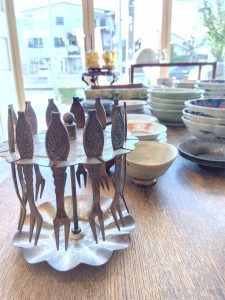「肉まん」と「豚まん」どちらで呼んでいますか?(愛知県名古屋市千種区姫池通 骨董買取 古美術風光舎)
2024.01.25
皆さまこんにちは。スタッフTでございます。
昨日ほどではないですが、今日も寒い一日です。日本中から「寒い」という声が聞こえてきそうです。

今日は1902年に北海道旭川市で日本気象観測史上最低の-41℃を観測した日に由来して、「日本最低気温の日」なのだそうですよ。名古屋の天気予報を見ると、今朝の最低気温は-1℃。これでも十分寒いのに、-41℃の世界はいったいどんな感じなのでしょう。そこまで寒くなると凍ったバナナで釘も打てちゃうんでしょうか。テレビでよくやるあのシーン、一度はやってみたいと思っています。
また、今日は、最低気温の日に因んで「中華まんの日」でもありました。
一年でもっとも寒いとされるこの時期に、ホカホカの中華まんを食べて身も心も温め、ホッと一息ついてほしいという思いが込められているのだそうです。
寒い時期に食べたくなる中華まんですが、「肉まん」「豚まん」皆さまはなんと呼びますか?
私、物心ついた時から名古屋に住んでおりますので、「肉まん」と呼んで親しんでおりましたが、最近のコンビニなどでは「肉まん」「豚まん」の両方を見かけます。一見同じもののようにみえるのですが、この中華まんの呼び方、関西方面では「豚まん」と呼ばれており、それ以外の地域では「肉まん」と呼ぶのが一般的のようです。
「中華まん」とは、小麦粉をこねて発酵させた皮で豚肉などの具材を包み、蒸しあげた饅頭のことです。肉まんと豚まんは、多少の味付けに違いはあるものの、基本的には同じもの。
では、なぜ関西だけ豚まんと呼ぶのか。それは、関東と関西の二つの食文化の違いにあるようです。
関東では、昔からさまざまな肉が食べられていましたが、関西では、松阪牛や神戸牛など牛肉の産地が多いことから、一般的に「肉」というと牛肉を指すことが多いのだそう。
他のお肉、例えば豚は「豚肉」、鶏は「かしわ」と呼び方を変えていたのだそう。そこから、「肉まん」というと「牛肉が入っている」と勘違いされてしまうため、「豚まん」という呼び方になったようです。
今では冬の定番として愛されている中華まんですが、もともとはお隣の中国で誕生した蒸し料理です。諸説ありますが、あの「三国志」で有名な諸葛亮孔明(しょかつりょうこうめい)が作らせたのが始まりだという説もあります。
諸葛亮孔明が南蛮征伐の帰りに濾水(ろすい)という川を渡ろうとしたところ、嵐で川が荒れ狂っていて渡ることができず、軍隊は足止めされて困っていました。当時、地元では「人間の首を捧げると水神が鎮まる」と信じられていたため、地元民が捧げる者を調達しようとしましたが「合戦で多くの命が失われたのに、これ以上の犠牲は出したくない」と孔明は一策を講じました。
そこで、自国の料理人をよんで「小麦粉をこねて、中に肉をつめ、人の頭の形に丸めたもの」を作らせます。孔明がこれを生首の代わりに川に投げ入れて祈祷すると、氾濫は鎮まり、蜀軍は無事に川を渡ることができたのだとか。このとき作られた「饅頭(まんとう)」が奈良時代に日本へ伝わり、さまざまな進化を遂げて中華まんになったといわれています。
なんと、肉まんのルーツは生首だったとは・・・しかし、肉まんでも豚まんでも美味しいことにかわりはありませんね。
今日はコンビニで温かい中華まんを買って帰りたいと思います。
ではでは、また。
Hello everyone. This is Staff T.
Today is another cold day, though not as cold as yesterday. I can hear people from all over Japan saying, “It’s so cold.
I heard that today is “Japan’s Lowest Temperature Day” because of the day in 1902 when -41°C, the lowest temperature ever observed in Japan’s meteorological observation history, was observed in Asahikawa, Hokkaido. According to the weather forecast for Nagoya, the lowest temperature this morning was -1℃. This is cold enough, but what is the world like at -41°C? I wonder if you can drive a nail with a frozen banana when it gets that cold. I would like to try that scene that is often shown on TV.
Today is also “Chinese bun day,” which is associated with the lowest temperature day.
It is said that during this coldest time of the year, people enjoy eating hot Chinese buns to warm their bodies and souls and take a breather.
Chinese steamed buns are a must-have during the cold season, but what do you call them?
I have lived in Nagoya for as long as I can remember, so I was familiar with the term “nikuman” (meat bun), but recently I have been seeing both “nikuman” and “buta-man” in convenience stores. At first glance, they seem to be the same thing, but in the Kansai region, they are called “pork buns,” while in other regions, they are generally called “nikuman” (meat buns).
A “Chinese bun” is a steamed bun with ingredients such as pork wrapped in a fermented flour dough. Although there are some differences in seasoning between “nikuman” and “buta-man”, they are basically the same.
So why is it that only in the Kansai region are they called “pork buns”? It seems to lie in the difference between the two food cultures of the Kanto and Kansai regions.
In the Kanto region, a variety of meats have long been eaten, but in the Kansai region, “meat” generally refers to beef, since there are many beef-producing regions, such as Matsusaka beef and Kobe beef.
Other meats, such as pork and chicken, were called “pork” and “kashiwa,” respectively. From there, the term “nikuman” was mistakenly thought to mean “containing beef,” so the term “pork bun” was used.
Nowadays, Chinese steamed buns are a beloved winter staple, but they originally originated in neighboring China. There are various theories, but some say that it was first made by Zhuge Liang Kongming, famous for his novel “The Legend of the Three Kingdoms.
When Zhuge Liang Kongming tried to cross the Losui River on his way back from conquering the southern barbarians, he was unable to do so because the river was raging due to a storm, and his troops were stranded and in trouble. At the time, the local people believed that offering a human head would appease the water god, and the local people tried to procure a person to do so, but Kongming came up with a plan, saying, “Many lives were lost in the battle, and I don’t want to cause further loss of lives.
He then invited his own cooks to prepare “a dish made by kneading flour, filling it with meat, and rolling it into the shape of a human head. When Confucius threw it into the river in place of a fresh head and prayed, the flooding subsided and the Shu army was able to cross the river safely. It is said that the “manju” made at this time was introduced to Japan during the Nara period (710-794) and evolved in various ways to become Chinese buns.
But there is no difference between the deliciousness of meat buns and pork buns.
Today, I would like to go to the convenience store and buy warm Chinese buns to take home.
*******************
ご実家の整理やお片付けなどをされている方のご相談などが多くございます。
お片付けなどくれぐれもご無理のないようになさってくださいませ。
風光舎では古美術品や骨董品の他にも絵画や宝石、趣味のお品など様々なジャンルのものを買受しております。
お片付けをされていて、こういうものでもいいのかしらと迷われているものでも、どうぞお気軽にご相談下さいませ。
また風光舎は、出張買取も強化しております。ご近所はもちろん、愛知県内、岐阜県、三重県その他の県へも出張いたします。
まずは、お電話お待ちしております。
愛知県名古屋市千種区姫池通
骨董 買取
【古美術 風光舎 名古屋店】
TEL052(734)8444
10:00-18:00 OPEN
#出張買取#骨董#古美術#骨董品#絵画#版画#茶道具#刀剣#彫刻

